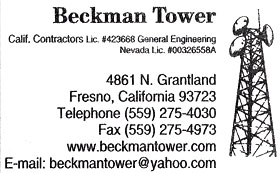Don’t feel so bad if your station ad revenues are a bit lighter after the election. According to recent published reports, Clear Channel is reporting about five billion dollars of debt. Panasonic posted an 8.8 billion dollar loss—not good for the company stock.
This week the FCC will have their open meeting to consider the adoption of Orders that finalize procedures to complete the processing of over 6,000 pending FM translator applications and complete the implementation of the Local Community Radio Act. According to the Commission, these are the final steps toward opening a filing window that will allow non-profit groups nationwide to apply for more low power radio licenses expanding the diversity of truly local voices in the media landscape. It will be interesting to see if this promotes, “public interest, convenience and necessity” without interference.
Speaking of FM, the move to get FM radio chips into all cell phones may have gotten a boost from hurricane Sandy. The director of FEMA admitted that cell phones and the internet are not 100 percent reliable when a natural disaster strikes. Radio saves the day, with redundancy and point to multi-point distribution.
Of course we probably won’t have predictable hurricanes here, but an unpredictable big earthquake IS a possibility. The following questions are from Clay Freinwald, former chairman of the SBE EAS committee and are worth reviewing:
In a disaster, unless you have a lot of luck and your stations plant comes through the event with none or only minor damage, one of your greatest assets is redundancy. A major quake will certainly take its toll on TV as well as Radio station facilities… Just scratching the surface, here are some things you might wish to consider:
Power outages –
Broadcasting takes power – without it, we have a collection of non-functioning equipment.- How many stations don’t have generators at their studios and transmitter facilities? Those that don’t are, in a post-quake world, not likely to be able to get one off the shelf.
- How many stations that do have generators are designed for long term use? They found out withSandy, the power could be out for weeks.
- What is the run time of your stations generator (without re-fueling)? Are you ready for a 2 week outage? Many facilities inSeattlehave big generators and tiny tanks.
- What guarantee do you have that you will be able to get your tank re-filled, perhaps multiple times? That notion that you can send someone to the local gas station for fuel might be a bit short-sighted if their power is out and they can’t pump it for you.
- Even if you find a place that has fuel, they might not be able to get their trucks to your tank…What then? Do you have redundant suppliers?
- With fuel (Gasoline or Diesel) in short supply, how are you going to be sure that you can get fuel and that it won’t end up going to someone else.
- Does your station have an agreement with local governments to assure that your needed fuel won’t be diverted to emergency vehicles etc?
- You might have a generator powered by natural gas. In windstorms, they are great, in quakes – that’s another story as the location of the gas lines, underground, is subject to major failures.
Communication Outages
As we found out during the Nisqually Quake a few years ago, telephones were useless. Dial-tone was extremely scarce and even if you heard it – no guarantee you could get a call through. Cellular was just as useless. The Internet may or may or may not be there. All of these systems may slowly go down as their generators run out of fuel etc. Cable TV is not likely to be functioning etc.- How are you going reach staff members, or news sources if the phones don’t work?
- The only thing that might work would be old-fashion 2-way or Ham Radio – Are you ready?
Studios
Typically studios are not built as rugged as transmitter sites due to their nature. Many are in leased facilities that were not designed to survive a major disaster or quake.- One gas main rupture (typical event in a major quake) or structural failure will cause the authorities to wrap your studio facilities in caution tape resulting in evacuation and no entry…What then? How do you broadcast without a studio?
- Let’s suppose your studios survive, you may find that your staff is limited and they end up living at the place – How are you going to handle needs like food, water, sanitation, sleeping etc.?
Transmitter Site Fall Back
How many stations can get on the air from their transmitter site, or are now co-located? In the good old days, this was common at many radio and some TV Stations. However, these days, it’s rare. Let’s assume your transmitter survived…
- What – in place – procedure do you have that will enable you to broadcast from there?
- What about sources of programming?
- What about staff support issues?
- Do your people even know how to get there, or get in and know what to do?
Priorities
A huge quake will cause many staff members to have to make quick priority decisions…
- Do they try and get home to take care of their family or stay and try and keep you on the air?
Redundancy
- How many stations have taken the time to do a cost/benefit study to determine just what is needed to stay on the air during a disaster and made decisions based on that work?
- How many stations have just rolled the dice and selected ‘gamble’ as their best answer?
Advance Planning
In general – Stations must – Work, plan, train and budget to stay on the air.- How many stations actually have a good, solid, emergency plan?
- How many stations have written their own plan without having someone from the outside, schooled in these matters, to evaluate it?
- How often are staff members trained in emergency procedures? (it’s just like CPR, training must be on-going)
- Does your stations emergency provide sufficient instructions that a semi-technical person could figure out how to keep you on the air if an Engineer is not on site to do the job?
- How many stations will actually allocate funds to address those ‘weakest links’ to stay on the air?
Dependency on Engineers
Most radio and TV stations can operate today for some time without the need for engineering support, however…When disaster strikes – Engineers are going to be called upon to restore the operation of every device that everyone determines is important to their job.
- In short, engineers will be overwhelmed, to say the least.
- Who is going to run interference for them?
- For radio, that uses contract engineers, i.e., no technical person on the premises when the need is the greatest –What are they to do?
- Small and Large stations can be brought to their knees (be off the air) without instant access to Engineers that know how to make it well again. I fear that a number of stations will not be able to get back on the air due to the lack of on-premise technical personnel.
News and Information Sources
During most disasters, stations who survive elect to provide news and information for the citizens within their coverage area. Back when I started in this business (yes 50 years ago)
Most stations had a news department. Today, very few do. The mode today is for stations that do not to begin re-broadcasting those stations that do. This brings up some questions –
- Does your station have, in place, re-broadcasting agreements?
- Does your station have the equipment necessary to allow this to take place?
WOW! That ought to stir some thoughts about enhancing your stations survivability.
This months gathering is a hosted lunch from the folks at JVC over at the Clovis HomeTown Buffet. Read more about it HERE. I hope to see you there on Thursday.



